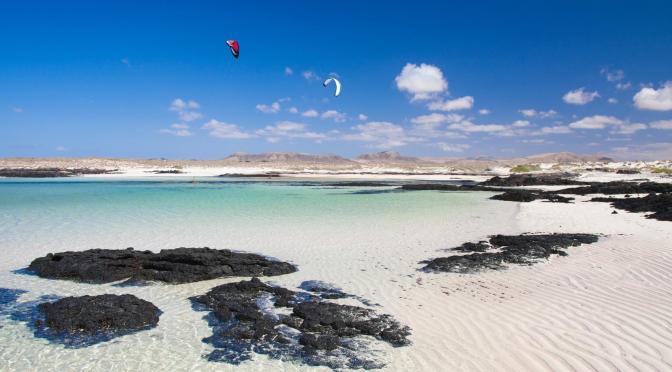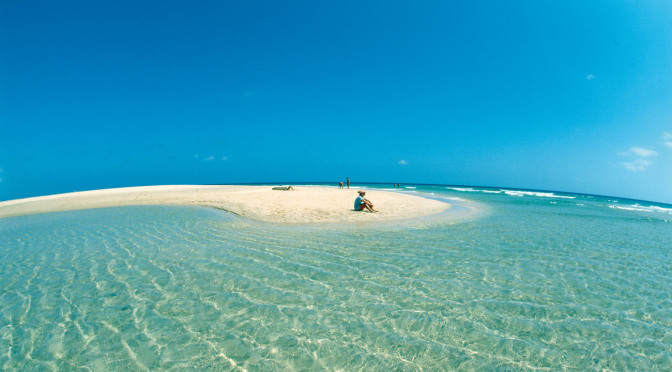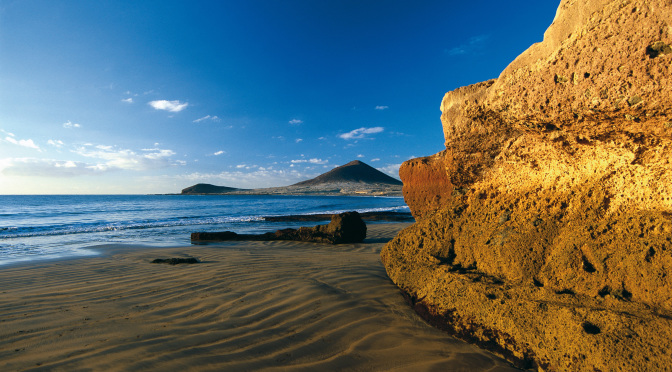Fuerteventura's most beautiful beaches: From the white sand dunes of Corralejo and the kilometer-long lagoons of Sotavento, to the black beaches of Tarajalejo, up to the wild expanses of Cofete. Fuerteventura really has beaches of all kinds for every taste: whether you want to surf or just sunbathe in total relaxation, this is the island for you!
Continue reading The most beautiful beaches of Fuerteventura
Islet of Los Lobos
A few kilometers off Corralejo lies the island of Los Lobos, a real piece of unspoiled paradise.
The island is uninhabited and Since 1982 it has been considered a natural park. The name derives from the fact that in the past the island was inhabited by numerous sea lions, known in Spanish as "sea wolves" (lobo means "wolf"), today at risk of extinction. Its origin is volcanic and the soil is characterized by arid lands and rocky landscapes, but also by beautiful sandy beaches. In Los Lobos it is possible to admire some very rare plant species, birds such as the herring gull and the greater shearwater, and on its coasts it is possible to spot seals and dolphins.
Cofete Cofete
beach is a long and charming white sand beach, southwest of the Jandia peninsula, which extends for about 5km. The wild and isolated charm of this beach is given by the fact that it is difficult to reach and is very often deserted and windy. Very large waves and strong currents break on the beach, therefore in case of very rough seas it is not advisable to swim: the area is very isolated and there is no lifeguard service in case of emergency. The beach can be reached by car following the completely unpaved road (about 20 km) which starts from Morro Jable towards the Faro de Punta Jandia which is located at the southern tip of the peninsula. Halfway, take the crossroads that goes up to the right for Cofete: once you reach the top of the pass, you can admire the entire west coast of Fuerteventura in a truly breathtaking landscape. From that point the road descends to the village which is a few tens of meters from the beach.
Morro Jable
Morro Jable develops around a promontory and its marina. The seafront starts from it, with numerous shops, restaurants and bars. Tourism is predominantly of German origin, as are the restaurants and bars of Morro Jable. The old part of the village, separated from the port by a promontory, stands on a "barranco" in the hills. The newer parts connect the old village to the port area, while the tourist settlements are located along the coast to the east of the town. Morro Jable beach is part of a long chain of natural white sand beaches. The beach to the east of the lighthouse is used by naturists, while the one to the west is used by ordinary bathers, and there are areas equipped with umbrellas, deck chairs and some boat rentals.
Jandia
The coast of Jandia extends south to the village of Morro Jable and boasts different types of beaches, from those with black sand or black pebbles, to others composed of small rocks. In the middle stands the Lighthouse of Jandia , in " Playa Del Matorral ", which not only serves as a warning to sailors, but divides the beach into naturist and non-naturist.
Sotavento
Sotavento is the largest beach in Fuerteventura and also the most famous.
It is located east of the peninsula of Jandìa, a few kilometers south of the town of Costa Calma. Wonderful and very long, it is the protagonist of windsurfing and kitesurfing competitions, and various beach parties are also organised. During the day, at low tide, a large lagoon forms which separates the beach into two strips of sand. Inside the lagoon, the water is very shallow and calm and windsurfing lessons are usually held sheltered from the impetuous currents.
La Pared
At La Pared there is a long golden sandy beach in the southwest of the island, very similar to the one located south of El Cotillo and a popular spot for many surfers. To get to the beach you have to take a concrete ladder that descends from the cliff.
Ajuy
Ajuy is a fishing village famous for its caves and is located on the west coast of Fuerteventura, in the municipality of Pajara. The village has a small black sand beach, surrounded by small fishermen's taverns and their colorful boats. the Quiet village of Ajuy is recommended for its fish restaurants and for being in contact with nature. Indeed, it is located at the entrance to the Barranco de Ajuy , where there is a large colony of palm trees.
Costa Calma
Costa Calma is an important resort in the south of Fuerteventura. Here the white sand and the blue sea form beautiful postcard beaches.
Tarajalejo
Tarajalejo is a small fishing village. The BEACH here is made up of sand and black pebbles of volcanic origin, and is very quiet and not very busy.
Gran Tarajal
Gran Tarajal is located on the east coast of Fuerteventura, and is one of the most populous cities on the island.
Its wonderful black sand beach contrasts with the wonderful blue of the sea.
Its waterfront and relaxed climate make it an ideal place for romantic strolls. On the beach of Gran Tarajal events, evenings and concerts are organized (among which we remember the Womad , a series of concerts that attract tens of thousands of spectators).
Las Playitas
Another nice black sand beach.
Pozo Negro
A fascinating beach of black sand and pebbles, little frequented by tourists as it can only be reached by car.
It is located east of Fuerteventura south of the airport and can be reached from the road that runs from north to south, following the signs indicating the junction for Pozo Negro. The atmosphere is calm and relaxing: the surrounding village is typical of fishermen, with white houses and a few small taverns.
Caleta de Fuste
Caleta de Fuste is a very popular resort town, south of Puerto del Rosario.
The town is gathered around a natural bay. The white sand is imported and the waters of the bay are affected by the influence of the tides: the waters advance and retreat considerably throughout the day. The Caleta de Fuste area is located in a protected habitat for marine species, and is an excellent starting point for snorkelling or diving excursions.
Playa Blanca
South of Puerto del Rosario, near the airport, is Playa Blanca. Thanks to its proximity to the airport terminal, you can admire the planes landing and taking off from the nearby runway up close. Check the flags displayed on the beach which indicate the degree of danger of the currents: in the event of a red flag you will have to keep no more than 15 meters from the shoreline. The particular conformation of the ocean floor often tends to generate undertows and reverse currents in the event of rough seas or strong winds.
Playa Chica
Playa Chica is a city beach, located in the city of Puerto del Rosario . The beach is very popular with the locals. The water is transparent and not rough: being close to a port, it is equipped with a breakwater that protects it from the ocean waves.
Corralejo Galera beach
Galera Beach is a beach located in the town of Corralejo. Definitely smaller than the nearby beaches of the Natural Park, it is often very crowded, especially by English tourists. The waters are generally calm and it is safe to swim.
Corralejo Playa El Burro El Burro
beach is located in the Corralejo Natural Park. The beach is dotted with corralitos , small circular walls built to shelter from gusts of wind, a real peculiarity of Fuerteventura.
Corralejo Natural Park
Corralejo is the main tourist resort in the north of Fuerteventura. Presence of numerous beaches, some of which are very close to the centre, while outside the city extends the natural park of Corralejo, with beaches and golden sand dunes that extend for several kilometres. Playas Grandes is very popular with surfers and is the ideal place for kite-surfing and windsurfing (there are numerous schools for learning these sports). In the Corralejo Natural Park, large sand dunes plunge into crystal clear water. The beach is huge and it is possible to practice nudism. The natural park area is a few minutes east of the center of Corralejo and can be reached by car or bicycle in a few minutes. If you want to stay directly on the beach, there are two large hotels overlooking the sea: Hotel Riu Palace Tres Islas and ClubHotel Riu Oliva Beach Resort .


